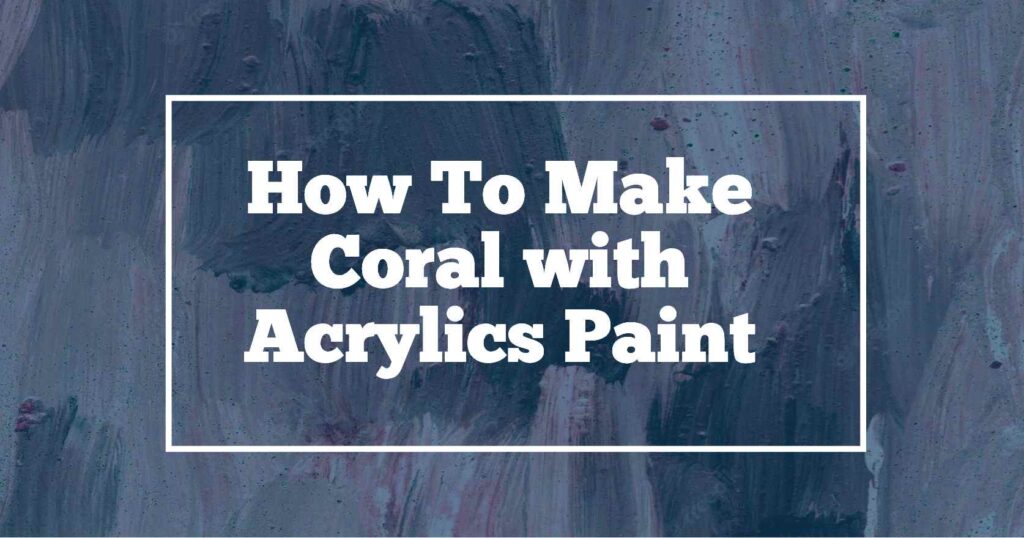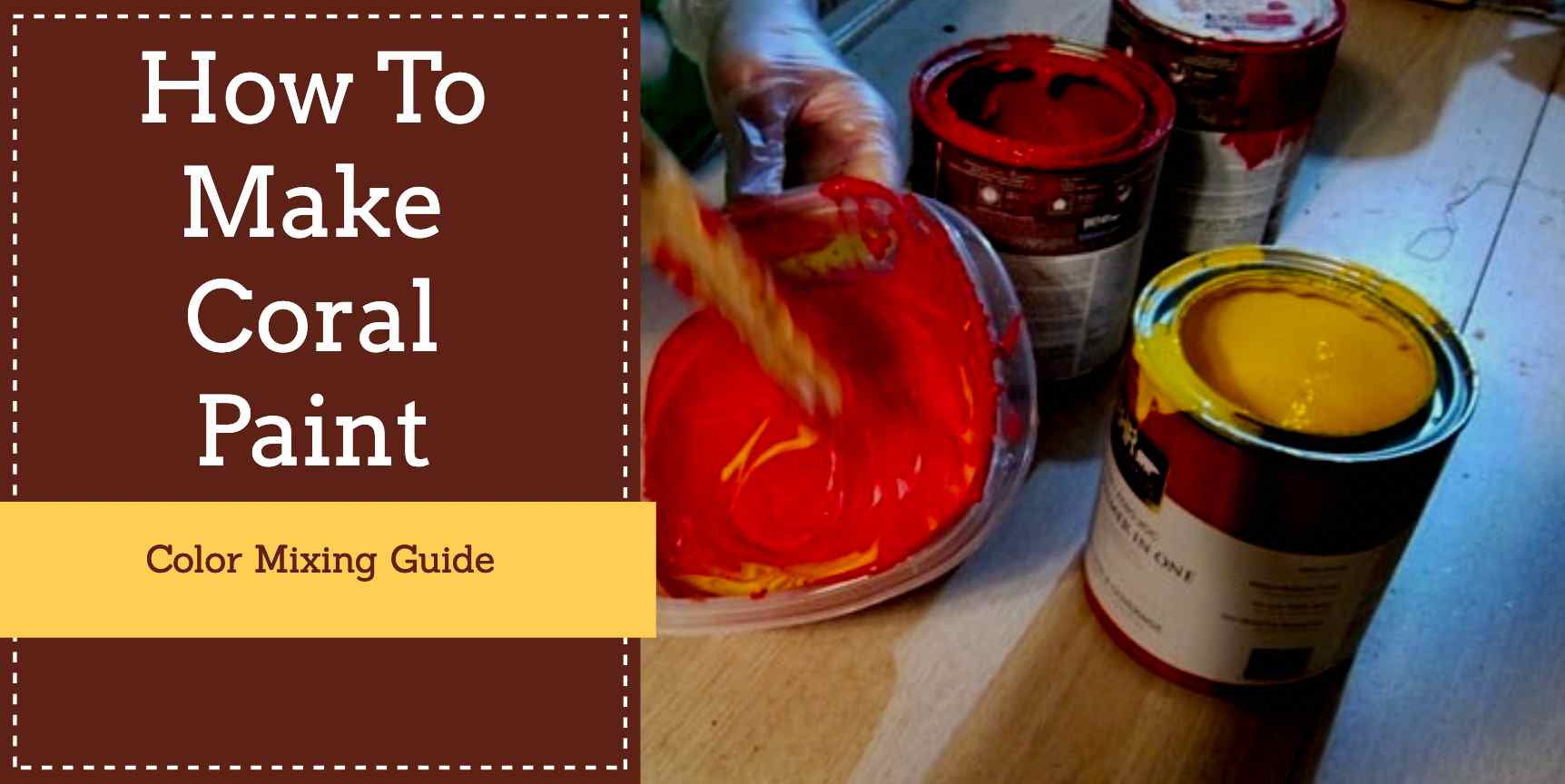You must’ve looked at Coral sometimes & maybe want to make it on your own. You might be thinking it’s hard, but it’s all about mixing right? All artists, new or experienced, love finding the perfect color. Let’s explore how to make coral paint with different types of paint. This will help you keep the color bright and clear. Want the shine of oil, the ease of acrylic, or the softness of watercolor? This guide got you covered from acrylic to oil paints & watercolor too. Here in this article, we’ll let you know about making coral paint at your own home by using any kind of paint you’ve. Ready to add coral to your art? Get your brushes, and let’s start! Every good painting starts with the first brush move.
Also Read: How to Make Skin Color Paint
What Color Combination Makes Coral Paint

Coral! It makes us think of warm beaches or lively markets. Want to make the perfect coral paint for your art project or surface? Don’t worry, With the right mix and method, you can. How? Start with bright orange, like the festive flowers on our streets. Add some pink, like rose petals from weddings. Mix them. Now, add a bit of white to make it soft and stand out. There! That’s your coral. It sounds easy, but balance is key. Too much pink? It’s rosy. Too much white? It’s peach. Just the right blend gives you coral. Remember these tips when you paint. Start with your colors and see the beauty of coral come alive!
How To Make Coral with Oil Paints: A Simple Guide
Imagine a busy market with colorful fabrics. There’s one color that stands out – coral. It’s like a warm sunset and a soft sunrise combined. Want to paint this on canvas using oil paints? Let’s go step by step.
1. Grab your materials : Get your oil paints. You need a bright orange (like fresh oranges), a clear pink (like spring flowers), and a plain white (like calm clouds). Also, keep a palette knife handy for mixing and a palette.
2. Start with Orange: Put a good amount of bright orange on your palette. This is our main coral color.
3. Add Some Pink: Mix in a little pink with the orange. Add it slowly. keep in mind we’re going for coral, not bright pink.
4. Add White: Now add some white. This makes the coral soft and creamy.
5. Mix Them Well: With your palette knife, mix the colors well. Oil paints blend nicely, but take your time to get it just right.
6. Try It Out: Before painting your main piece, test your coral on scrap paper or canvas. Check it in different lights to make sure it’s perfect.
There you go! A beautiful coral paint with oil paints. Every artist’s coral might look a bit different, and that’s okay. It’s your own perception. Now, go paint with your new coral color. Enjoy!
How To Make Coral with Acrylics Paint: A Simple Guide

Think of the festival’s colors. In those colors, coral stands out, like the beautiful shades in royal palaces. Want to paint with this using acrylics? Let’s learn how.
1. Get Your Paints: Gather your acrylic paints. You need a bright orange, a deep pink, and pure white. Also, have a mixing palette and a spatula or brush.
2. Start with Orange: Put a lot of orange on your palette. This is the main part of our coral.
3. Add Some Pink: Now, add some pink to the orange. But add it little by little. We want coral, not dark pink.
4. Mix in White: Then, add some white. This gives the coral its soft, pastel look.
5. Blend Well: Acrylics are easy to mix. Blend the colors with your spatula or brush. If it looks off, adjust by adding more color.
6. Test It: Before painting your artwork, test the coral on a small piece of paper. Make sure it’s the right shade.
There you made it your own coral paint with acrylics! The steps might seem easy, but the little details make it unique. Now, go paint and enjoy every brushstroke with your new coral shade!
Also Read: How to Make Peach Paint
How To Make Coral Paint with Watercolors: An Easy Guide
As we’ve already told you about making coral paint using Acrylic & oil paints, next comes in watercolor it’s something same to the previous methods. So, Let’s explore making coral paint with watercolors.
1. Set Your Tools: First, get your watercolors. You need a bright orange, a soft pink , and a clean white. Also, have a palette for mixing, a dropper, and a smooth brush.
2. Start with Orange: Take a good amount of orange with your brush and put it on your palette. This orange is the main part of our coral.
3. Add Some Pink: Slowly mix in some pink. Be gentle. Watercolors are soft shades. Let the orange and pink blend smoothly.
4. Softening with White: Add a little white to the mix. With watercolors, the white makes the color softer, giving that dreamy coral feel.
5. Get the Right Flow: If your color feels too thick, add a drop of water. But be careful, too much water can wash out the color.
6. Try It First: Before painting your art project, test the coral on a spare piece of paper. Let it dry. Watercolors can change a bit when they dry, so this step makes sure you’ve got it right.
And that’s it! You now have a beautiful coral shade in watercolor. This mix is all about balance and softness. Now, enjoy painting with your lovely new color.
FAQs on Crafting the Coral Hue across Different Paint Mediums
1. What are the basic colors required across all mediums to achieve coral paint?
Regardless of the medium, you’ll primarily need lively orange, a passionate pink, and a little white to bring that soft tone.
2. How does mixing differ between oil paints, acrylics, and watercolors?
When using oil paints, you need to mix the colors slowly and be patient. But with acrylic paints, they dry quickly so you have to mix them fast. Watercolors mix with water, which changes how they look and flow.
3. I’ve heard oil paints take longer to dry. Will this affect my coral shade?
Oil paints dry slowly, so you have more time to get the color right on the canvas. The color doesn’t change much as it dries, but it’s good to have fresh air to help it dry faster.
4. Can I just purchase ready-made coral in acrylic or watercolor?
It’s fun to mix your own colors because you can get the exact shade you want. It’s like the difference between buying food from a store and making it at home exactly how you like it.
5. Any tips to ensure I get the same coral consistency every time, especially with watercolors?
With oil and acrylic, consistency can be achieved by remembering your color ratios. With watercolors, it’s a bit trickier due to water dilution. A good practice is to maintain a mixing journal, noting down your ratios and water additions.
6. I want my coral darker/lighter in watercolors. Any advice?
Certainly! For a darker shade, consider adding a small touch of brown or deep orange. For lighter hues, dilute with water or add a pinch more white. Remember, with watercolors, it’s all about the play of water and pigment.
7. How do I store my mixed coral paint, especially oil-based?
For oil and acrylic, a sealed, airtight container works wonders. Keep them away from direct sunlight or extreme cold. As for watercolors, if you’ve mixed a good quantity, store it in a tiny jar. But most of the times, artists prefer mixing fresh for each session.
Conclusion
We explored different ways to make coral paint at home, each with its own style. Acrylics mix fast, oils need time, and watercolors flow smoothly, all showing the beauty of coral. Mixing colors is like mixing ingredients in cooking. But it’s not just about how to paint; it’s about the unique feeling each painting gives. In the end, no matter which paint you use, your personal touch brings the picture to life. Keep painting and let each artwork tell its own story.

